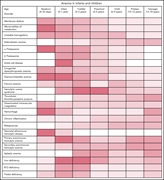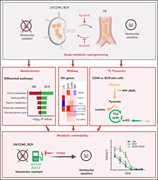Issue Archive
Table of Contents
EDITORIAL
Introduction to a review series on pediatric hematology
Commissioned and introduced by Associate Editors Irene Roberts and Thomas Ortel, this Review Series focuses on common areas in pediatric hematology practice, emphasizing new therapeutic and diagnostic developments. The specific challenges of managing hemostatic and thrombotic disorders in children are described by O’Brien and Zia. Distinguishing acquired immune diseases from inherited disorders of blood counts is a common problem for pediatric hematologists, and this is tackled in reviews by Grace and Lambert for thrombocytopenias and by Dokal et al for bone marrow failure. Finally, Gallagher provides a stepwise approach to the diagnosis and treatment of anemia in infancy and childhood, at both the individual patient level and the population level.
BLOOD COMMENTARIES
REVIEW SERIES
Hemostatic and thrombotic disorders in the pediatric patient
Commissioned and introduced by Associate Editors Irene Roberts and Thomas Ortel, this Review Series focuses on common areas in pediatric hematology practice, emphasizing new therapeutic and diagnostic developments. The specific challenges of managing hemostatic and thrombotic disorders in children are described by O’Brien and Zia. Distinguishing acquired immune diseases from inherited disorders of blood counts is a common problem for pediatric hematologists, and this is tackled in reviews by Grace and Lambert for thrombocytopenias and by Dokal et al for bone marrow failure. Finally, Gallagher provides a stepwise approach to the diagnosis and treatment of anemia in infancy and childhood, at both the individual patient level and the population level.
An update on pediatric ITP: differentiating primary ITP, IPD, and PID
Commissioned and introduced by Associate Editors Irene Roberts and Thomas Ortel, this Review Series focuses on common areas in pediatric hematology practice, emphasizing new therapeutic and diagnostic developments. The specific challenges of managing hemostatic and thrombotic disorders in children are described by O’Brien and Zia. Distinguishing acquired immune diseases from inherited disorders of blood counts is a common problem for pediatric hematologists, and this is tackled in reviews by Grace and Lambert for thrombocytopenias and by Dokal et al for bone marrow failure. Finally, Gallagher provides a stepwise approach to the diagnosis and treatment of anemia in infancy and childhood, at both the individual patient level and the population level.
Inherited bone marrow failure in the pediatric patient
Commissioned and introduced by Associate Editors Irene Roberts and Thomas Ortel, this Review Series focuses on common areas in pediatric hematology practice, emphasizing new therapeutic and diagnostic developments. The specific challenges of managing hemostatic and thrombotic disorders in children are described by O’Brien and Zia. Distinguishing acquired immune diseases from inherited disorders of blood counts is a common problem for pediatric hematologists, and this is tackled in reviews by Grace and Lambert for thrombocytopenias and by Dokal et al for bone marrow failure. Finally, Gallagher provides a stepwise approach to the diagnosis and treatment of anemia in infancy and childhood, at both the individual patient level and the population level.
Anemia in the pediatric patient
Commissioned and introduced by Associate Editors Irene Roberts and Thomas Ortel, this Review Series focuses on common areas in pediatric hematology practice, emphasizing new therapeutic and diagnostic developments. The specific challenges of managing hemostatic and thrombotic disorders in children are described by O’Brien and Zia. Distinguishing acquired immune diseases from inherited disorders of blood counts is a common problem for pediatric hematologists, and this is tackled in reviews by Grace and Lambert for thrombocytopenias and by Dokal et al for bone marrow failure. Finally, Gallagher provides a stepwise approach to the diagnosis and treatment of anemia in infancy and childhood, at both the individual patient level and the population level.
CLINICAL TRIALS AND OBSERVATIONS
Daratumumab in first-line therapy is cost-effective in transplant-eligible patients with newly diagnosed myeloma
Clinical Trials & Observations
Yamamoto and colleagues modeled the cost-effectiveness of daratumumab as part of first-line combination therapy for newly diagnosed transplant-eligible patients with multiple myeloma. Using randomized trial data and cost estimates from Japan and the United States, they compared first- versus second-line use of daratumumab and report that first-line use delivers additional quality-adjusted life years over second-line use and is more cost-effective. These data suggest that if daratumumab is to be used in 1 line of therapy, then it should be in the first line.
HEMATOPOIESIS AND STEM CELLS
IMMUNOBIOLOGY AND IMMUNOTHERAPY
Cytosine base editing enables quadruple-edited allogeneic CART cells for T-ALL
Diorio et al harnessed new “base editing” technology to develop a quadruple gene-edited CD7-specific chimeric antigen receptor (CAR) T-cell product for “off-the-shelf” use in patients with T-cell acute lymphoblastic leukemia (T-ALL) and other CD7+ malignancies. The authors’ data show potent activity in vitro and in vivo in patient-derived xenografts. Their methodology proposes an allogeneic approach that is promising for clinical translation and showcases the potential of base editing for improved and more accessible CAR T-cell therapies.
LYMPHOID NEOPLASIA
Characterization of metabolic alterations of chronic lymphocytic leukemia in the lymph node microenvironment
The metabolic state of any cell varies with cell cycle and interactions with the microenvironment. Chen and colleagues studied changes in chronic lymphocytic leukemia cell metabolism in samples from patients recently started on ibrutinib and modeled these changes in vitro. Their data indicate major changes in glycolysis, the tricarboxylic acid cycle and amino acid metabolism, implicating these in the modulation of responses to therapies and suggesting that limiting glutamine may enhance responses to venetoclax.
MYELOID NEOPLASIA
Mutated SETBP1 activates transcription of Myc programs to accelerate CSF3R-driven myeloproliferative neoplasms
Mutations in the CSF3R and SETBP1 genes commonly co-occur in chronic neurophilic leukemia (CNL) and atypical chronic myeloid leukemia, 2 rare BCR-ABL1-negative myeloid neoplasms displaying prominent granulocytosis. Carratt and colleagues modeled this occurrence in mice, revealing that SETBP1 induces a Myc-driven transcriptional program that promotes leukemogenesis on a CSF3R mutant background. Execution of this program is dependent on LSD1, and in vivo data suggest that combining inhibitors of JAK2 and LSD1 may be effective in treating CNL.
LETTER TO BLOOD
A core group of structurally similar HLA-DPB1 alleles drives permissiveness after hematopoietic cell transplantation
BLOOD WORK
-
Cover Image
Cover Image
![issue cover]()
Murine hematopoietic progenitors immortalized by coexpression of a constitutively expressed CSF3RT618I construct and a doxycycline-inducible SETBP1D868N vector. Image of cells 48 hours after removal of doxycycline, which silences SETBP1D868N expression and induces differentiation. See the article by Carratt et al on page 644.
- PDF Icon Front MatterFront Matter
- PDF Icon Table of ContentsTable of Contents
- PDF Icon Back MatterBack Matter
- PDF Icon Editorial BoardEditorial Board
Advertisement intended for health care professionals
Email alerts
Advertisement intended for health care professionals











Cost-effectiveness: maximizing impact by meticulous data
Clinical Trials & Observations